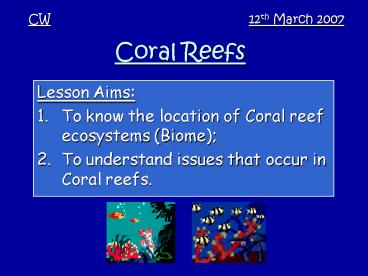Coral Reefs - PowerPoint PPT Presentation
1 / 15
Title:
Coral Reefs
Description:
Kenya has many miles of Coral reef which attracts holiday makers. Coral reef in Kenya ... Ocean coast offers fabulous beaches, a tropical climate, and some ... – PowerPoint PPT presentation
Number of Views:424
Avg rating:3.0/5.0
Title: Coral Reefs
1
Coral Reefs
CW
12th March 2007
- Lesson Aims
- To know the location of Coral reef ecosystems
(Biome) - To understand issues that occur in Coral reefs.
2
(No Transcript)
3
Coral reef biology
- The building blocks of coral reefs are the
generations of reef-building corals, and other
organisms that are composed of calcium carbonate - As coral sheds parts, gets eaten by fish, or
simply just dies, the calcium carbonate builds up
in layers - This literally builds a reef- an ecosystem of
live organisms under warm waters
4
(No Transcript)
5
(No Transcript)
6
Where Coral reef can be found-
Kenya has many miles of Coral reef which attracts
holiday makers
Coral reefs are estimated to cover 284,300 square
kilometres, with the Indo-Pacific region
(including the Red Sea, Indian Ocean, Southeast
Asia and the Pacific) accounting for 91.9 percent
of the total
7
Coral reef in Kenya
- About 70 of the coastal population in Kenya
depends on fisheries and tourism for their
livelihood - With increasing poverty and mouths to feed,
fishing continues in the coral reef of Kenya - Traditional fishing methods are being replaced by
use of destructive methods - This is destroying the coral, and reducing fish
numbers - This means that even before tourists get to
Kenya, they are already harming the coral reef
ecosystem
8
Tourists pay for guided snorkelling tours of the
Coral
9
This boat is damaging the Coral ecosystem. How?
10
Positive impacts of tourism
- The Indian Ocean coast offers fabulous beaches, a
tropical climate, and some of the best scuba
diving in the world. This attracts a lot of
tourists - Tourism has generated jobs in scuba diving-
offering lessons, guided tours and mini-trips out
to the coral. - There has been an improvement in roads to and
from the coastal resorts which also helps the
local fishing industry. - Profits from tourism may be invested in education
and other programmes for local communities. - Identification of coral reef areas means that
conservation can take place- managing the coral
so that it remains in place
11
Negative impacts of tourism
- The huge numbers of visitors are damaging the
coral reefs. Boats and divers themselves can
damage the fragile coral very easily - The scuba diving teachers, and guides earn a
relatively small wage considering the work they
do, and how much people pay for their holidays. - A large percentage of the money earned by
tourists paying to scuba dive in the Indian ocean
goes back to the tour operators and large hotel
chains, which are based in countries like the
United States and Great Britain. - The massive tourist developments on the Indian
Ocean coastline have caused an increase in house
prices in the area, meaning that the locals are
priced out of the market. - The tourists are only adding to the damage to the
coral being caused by local fishers
12
Healthy Coral, being used in an eco-friendly way
Coral that has been destroyed through over
fishing, bad management, or even through blast
fishing
13
(No Transcript)
14
The table shows the percentage of each countrys
GNP that comes from tourism. a) Which country is
most dependant on tourism? (1 mark) b) What type
of holiday do LEDCs, like Egypt, offer to
tourists? (2 marks) c) What are the advantages
and disadvantages of encouraging tourism in
LEDCs? (6 marks) d) How can tourism be
encouraged in LEDCs without destroying the
environment? (3 marks) (Marks available 12)
15
Homework
- Start to fact find on Kenya
- Photos / data on-
- Climate (maybe a climate graph for Nairobi)
www.worldclimate.com - Types of tourism
- Tourism facts
- Pics of Savannah / Coral reefs






























